Perioral Dermatitis
- Best Results2-6 weeks
- Treatment RecoveryNA
- Procedure TimeNA
- Skin SpecialistDermatologist
- Duration of ResultsLong lasting
- AnaestheticNA
- Back to WorkNA
- Cost$
Perioral Dermatitis
Perioral dermatitis or POD is the most common inflammatory rash seen by dermatologists. It is also termed steroid induced rosacea. I used to treat half a dozen cases daily when I practiced medical dermatology in the mid 2000s. This condition is easy to diagnose, & in most cases, even easier to treat. Be guided by your dermatologist.
FactsFacts on Perioral Dermatitis
- This is the most common rash seen by dermatologists
- It presents as tiny bumps around the nose, mouth & occasionally eyes
- The most common cause are steroid preparations
- Treatment is simple. Stop all your skincare actives
- Stop sunscreen application for one week; minimise makeup
- Take some prescribed anti-inflammatory tablets for 4 to 6 weeks
- Gradually re-introduce appropriate skin care once your rash settles
- A minimalistic approach to skin care is advised
What is Perioral Dermatitis or POD?
This is a very common rash that occurs around the nose & mouth area, hence the name perioral. It can also affect the eye area (periocular dermatitis). The onset is insidious & however, it can be persistent & resistant to over-the-counter creams. POD looks like tiny red dots most often with slight scaling. It is frequently confused with eczema or fungal acne.
What causes POD?
In some cases, the causative agent is straightforward- usually a steroid cream (Sigmacort, Elocon, Betnovate, Novosone) or an antifungal like Kenacomb. In others it is secondary to eczema creams like Elidel or Protopic. This is termed steroid induced acne.
Other cases are multifactorial, including too much skin care actives, occlusive topicals, leaving on makeup too long, not letting your skin breathe enough or, most often a combination of the above. The good news is that the diagnosis is straightforward as is the treatment.
What is the treatment?
If you want a fast and effective address, a course of anti-inflammatory antibiotics will sort out 90% of perioral dermatitis. First line treatments include doxycycline 50 -100mg, minocycline 50-100 mg, & erythromycin 400 -800mg twice a day. Your rash will start to improve within 2-3 weeks, albeit a purge period of 1-2 weeks in some cases (steroid induced POD). You should continue these tablets for 6-8 weeks.
Disclaimer: I do not treat rashes, including perioral dermatitis. See a medical dermatologist.
What is the best skincare routine when treating perioral dermatitis?
A minimalistic one. This means put all your skin care products on hold for the next few weeks. Your treating dermatologist will have their own guide. A simple formulated routine looks like this-
AM: Wash with Cetaphil, QV Gentle wash, or La Roche Posay Toleriane. Skip sunscreen application for 5-8 days. Use a light moisturizer, eg. La Roche Posay Ultra-Light Daily Moisturizer.
PM: Wash with above. Option to add azelaic acid 15% at week two. Moisturise as above.
Stop all actives including retinol, ascorbic acid, AHAs, BHAs, pigment correctors, soaps, toners, essential oils, & occlusive moisturisers. Stop all prescription medications unless directed to do so by your dermatologist. Ideally stop makeup & sunscreen for one week.
Why should you continue your anti-inflammatory medications for 6 weeks?
Because research has shown that a prolonged course of doxycycline, minocycline or erythromycin gives the best results. You can stop earlier, but your remission rate is markedly reduced.

View our Treatment Gallery
When is a flare up of perioral dermatitis probable?
Usually in the first week. This is commonly seen if you have been using steroid creams such as Elocon, Betnovate, or Dirposone. Think of it as purging. If you stick with your dermatologist’s instructions, you will be fine. Hopefully.
Some dermatologists may elect to prescribe you a weaker steroid such as hydrocortisone to wean off the stronger one. This will reduce flare ups.
Can you use makeup during treatment of perioral dermatitis?
Ideally no. You will get better faster without your makeup, however most dermos are practical & will ask you to use as little make up as possible. Trying going makeup free for three days. The other option is to swap to a paraben free or talc free makeup. My therapists at The Formulated can guide you through mineral makeup.
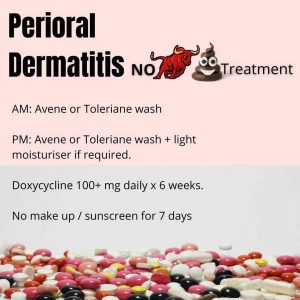
Though I don’t treat medical cases, including perioral dermatitis, I suspect that cases are on the rise, primarily due to trend of using too many skincare products as well as occlusion from masks AKA #maskne. On some days I diagnose 3-4 cases as incidental findings
The incidence of perioral dermatitis is at an all time high. The skincare craze, coupled with occlusion & humidity of masks have contributed to this explosion of cases
Though my work is procedural, I see an extraordinary amount of irritant contact dermatitis, perioral dermatitis, & rosacea flare ups. A significant amount of cases are due to overzealous skin care. Hopefully this tip will help. Comment below if you have learned that simple is often best!
Basic skin care 101, keep things simple. This can reduce skin irritation & accelerate your skin care journey
.
👉Perioral dermatitis: Acne like rash without #blackheads that occur around the mouth sparing the vermilion border. Can affect the eye area. Can be due to corticosteroids creams, antifungals, CS inhalers, occlusive products, too much product use, occlusion or a combination of all of the above
.
💊📝Treatment: as per post. If you are really serious about prompt resolution, stop everything, including sunscreen (just for a few days). Your rash will probably flare up (esp if it’s related to corticosteroids). Oral anti-inflammatories for 4-6 weeks
.
😁👉Other fluffy stuff: if you got time on your hands you can try azelaic acid, erythromycin gel, tacrolimus, topical clindamycin, pimocrimumus, LED therapy
.
🎬Action: if you are still struggling with perioral dermatitis, book an appointment with our medical dermatologists at Cutis Dermatology Brisbane. Yes, our IG is still hacked by some Nigerian sh*thead. No I’m not into bitcoin 🤑💰💵
.
😎Dr Davin Lim
Dermatologist
Brisbane🇦🇺
#perioraldermatitis #dermatologist #drdavinlim #davinlim #skincare #skincaretips #skincareroutine #dermaltherapy #skin #brisbanedermatologist #dermatologybrisbane
.
🤔What is it? Perioral dermatitis or POD consists of erythematous papules & bumps around the mouth, nose & occasionally eyes. It can sting or itch. The onset is insidious, however when established POD is persistent. Sparing of the vermillion border is common
.
❓What causes it? Cause & affect with topical, intranasal & ocular corticosteroids. Other cases are multifactorial including occlusive makeup, too much skin care (now probably the number one cause), heat, humidity- think #maskne.
.
💊How to manage? A dermatologist can diagnose & manage with a course of anti-inflammatory antibiotics will do the trick in the majority of cases. Ideally for 6 weeks. Doxycycline, tetracycline, minocycline or erythromycin. Topicals include clindamycin, erythromycin, & azelaic acid. Tablets much more effective compared to topicals
.
👍🏻💯Helpful Hints? Stop sunscreen & make up for one week. This will speed up resolution as occlusion is markedly reduced. You can restart a precise skin care routine with targeted actives (depending on your concerns) under the guidance of an expert. If you are prone to POD, simple skin care is best. Avoid occlusive products such as essential oils
.
👊Who to see? Your GP or dermatologist. My colleagues @cliniccutis can assist
.
😎Davin Lim
Dermo
Brisbane 🇦🇺
@drdavinlim
.
#skincare #steroidphobia #steroids #perioraldermatitis #rosacea #acne #rosacea #dermatologist #drdavinlim #skincare #skincaretips #skincarescience #dermalscience
.
Disclaimer: I do not treat perioral dermatitis as my work is procedural
.
.
👉The concept of irritant dermatitis is easy to understand. At some point, your skin’s threshold will be surpassed & irritation WILL occur. This threshold is different for everyone. #dermatitis, eczema, #rosacea & even #acne can decrease one’s threshold. Using the wrong products, high concentrations, or crappy formulations can compound the situation. Over washing can lead to irritant contact dermatitis (even to water)
.
.
🎯Precision Skin Care: Most dermatologist will have a very simple #skincare routine, #SPF as the foundation, a #retinol or #retinoid at night, & combination #antioxidants in the am. Occasionally we may add other actives like #AHA as a chemical exfoliant. I am pretty sure my colleagues don’t have a 10 step routine. Precision skin care is implementing active ingredient/s to address your primary concern, in some cases it is #antiaging in others it maybe #melasma, #pigmentation, acne or inflammation. Don’t use stuff just for the sake of a skin care routine. Be precise & simplify. This will save you a trip to the dermatologist for iatrogenic rashes👍🏻
.
.
😎Dr Davin Lim
@drdavinlim @cliniccutis
.
Brisbane🇦🇺
#skin #skincaretips #skincarecommunity #instaskincare #dermatology #dermatologist #drdavinlim #davinlim #perioraldermatitis #acneskincare #rosaceaskincare #rosaceatips #skincarescience #skinscience #dermatologistbrisbane
.
.
Disclaimer: I do not treat rashes, skin irritation or potential allergies. Best see my medical colleagues @cliniccutis. For skin care advice, consult my nurses & dermal therapists, we all adopt similar skin care philosophies, so don’t expect a hard sell of a zillion products.
.
.
🔬👍🏻Sunscreens: Foundation of everything from photo aging to #rosacea #melasma & even reducing marks from #acne. Choose one you are going to use. Use it regularly, minimum twice a day, 3 to 5 mls face & neck. SPF 30 or higher. I do recommend 50+ NOT just because of the higher factor but predominantly because people do not use enough. Linear scale of application. Half the quantity applied equals half the SPF
.
.
👀Retinol Vs Retinoids. Walk before you run. Most patients find it hard initially to modulate #retinoid application, side effects such as dryness, flaky skin, redness, purging etc… are universally seen with retinoids. It is a balance between application amount, frequency & irritant threshold. Start with a GOOD FORMULATION of #retinol, not a cheap one
.
.
🛡Antioxidants: #ascorbicacid, #ferulicacid, #tocopherol are mainstream antioxidants. #arganoil, #greentea #ginseng & other botanicals can be secondary #antioxidants.
Use in the am. These compounds mop up collagen damaging free radicals that get through your sunscreen application
.
.
👉💯Tip: Do not overcomplicate skin care products, especially if you have sensitive skin. Dermatologists see a whole lot of irritant dermatitis & even more perioral dermatitis due to overzealous product use. For a tailored product guide, consult my clinical team @cliniccutis. My work is entirely procedural, if you have sensitive skin, rashes, etc… my medical colleagues can assist
.
.
😎Dr Davin Lim
Dermatologist, Brisbane🇦🇺
.
.
#sunscreens #spf #skincare #skincaretips #skincarescience #skincarecommunity #instaskincare #drdavinlim #davinlim #skincareguide #glowingskin #antiaging
Should you stop using sunscreen if you have perioral dermatitis?
Does a bear sh*t in the woods? Hell yes. Hear me out. I am not saying never use sunscreen, just stop it for one week to let your skin breathe & purge. Sunscreens can be occlusive, especially physical sunscreen. You may want to start with a light moisturiser with an SPF before reintroducing sunscreens. La Roche Posay & Melan 130 are lighter sunscreens with SPFs of 50 & 130 respectively.
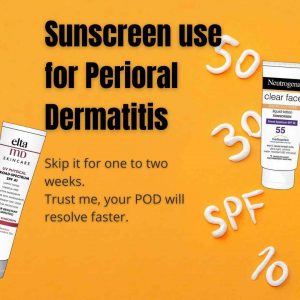
What if your rash comes back after stopping your tablets?
You have an option to go for another 6-week course, or your dermatologist may elect to swap anti-inflammatory medications. For example, if you are on doxycycline 50 mg daily, they may increase the dose to twice a day, or swap it to minocycline. Alternatively, they may add tacrolimus or pimecrolimus ointment, or a topical antibiotic such as clindamycin or erythromycin as an adjunct. For resistant cases they may consider isotretinoin.
Disclaimer: I do not treat perioral dermatitis as this is medical. Be guided by your dermatologist. If you do not have a dermo, my colleagues at Clinic Cutis can help.
What should you do if you have recurrent perioral dermatitis?
Troubleshoot with your dermatologist. It could be that –
- You are still using steroids intermittently
- Your anti-inflammatory course need to be longer
- Your skincare routine is wrong (too much)
- Your makeup is wrong (too occlusive or too much)
- Your diagnosis is wrong (your dermatologist will re-explore)
- Your POD is resistant to treatment (your dermatologist will work it out)
Disclaimer: I do not treat POD. My work is procedural only. Please see a medical dermatologist.

Can creams instead of tablets be used to treat perioral dermatitis?
Yup, but creams don’t work as well or as fast as tablets. If you are prepared for a longer wait & keep visiting a dermatologist, sure, use creams. Your specialist may elect to prescribe topical azelaic acid, erythromycin, clindamycin, minocycline (in the US), metronidazole or tacrolimus (double edge topical). It takes 6-10 weeks to see if creams help, if at all.
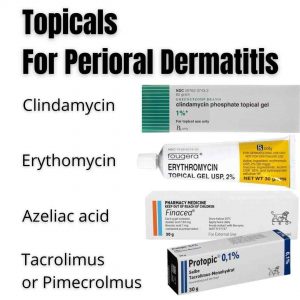
Your dermatologist may elect to use category A topicals such as erythomycin or clindamycin if you are pregnant – lactating. Be guided by them.
Can lasers help?
Yes, but they are adjunctive to oral or topical anti-inflammatories. Lasers are great for treating redness associated with inflammation. They are not primary treatments for POD. This is a simple procedure. My nurses perform vascular lasers for redness. You do not need to see me for this treatment.
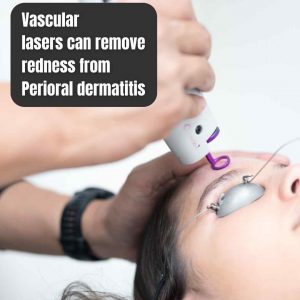
Call Clinic Cutis for a booking. Costs range from $260 to $360 with my nurses. As a reference, I normally charge $940, hence for simple cases like POD, see my team.
Can LED treatments help?
Yes, but they are adjunctive to topical or oral antibiotics. Red or yellow light 810 to 830+ nm light can help reduce inflammation. You may require 3-6 sessions, again this is adjunctive.
Can perioral dermatitis be due to an allergic reaction?
Unlikely. Certain skin allergies to nickel, metals, acrylates, & acetone may mimic perioral dermatitis, especially if there is eyelid involvement. Your treating dermatologist may elect to undertake patch testing if your skin is not better after anti-inflammatory medications.
Disclaimer: I do not get involved in patch testing or allergy testing. This is done by a medical dermatologist.
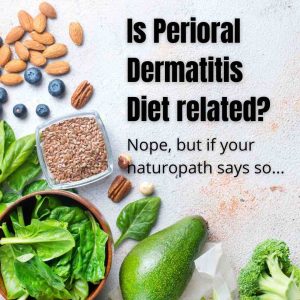
Can perioral dermatitis be secondary to diet?
Technically unlikely, but foods can cause allergic reactions that resemble perioral dermatitis. Allergic reactions usually involve the vermillion border, perioral dermatitis spares the border. Allergic reactions can occur with fluoridated toothpaste, as well as foods such as mango, garlic, and acidic foods like citrus & tomatoes. Your dermatologist can tell the difference between allergies and perioral dermatitis.
As a guide, when I did medical dermatology 15 years ago, for every 200 perioral dermatitis patients, I may pick up one allergy. Common things occur commonly.
Disclaimer: I do treat rashes. This is done by a medical dermatologist.
How do you go back to your normal skin care routine?
Slowly & with guidance from your dermatologist. They may elect to cull some of your skin care products including heavy occlusive ointments & creams, typically petroleum-based products. They may ask you to change to a lighter moisturizer such as La Roche Posay Ultralight, Rosaliac, or Toleriane light. Potentially irritating actives such as ascorbic acid or retinol should be carefully introduced.

They may also ask you to review your current make-up range, in favour of talc & paraben free mineral makeup. It would be a good idea to avoid makeup for 2-3 days a week. This will reduce the chances of POD recurrence.
Disclaimer: My job is procedural, I do not treat POD, nor give formal skin care advice. Be guided by your specialist.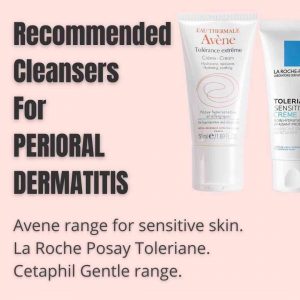
What is a good skin care routine if you are prone to perioral dermatitis?
A minimalistic one with a light moisturizer & mineral make up. One of the causative factors for POD is occlusion & too much sh*t on your skin. If you are prone to POD & you are a skin care junkie, chances are it is going to be chronic. An example of minimalistic skin care is-
AM: Gentle non-foaming cleanser. Sunscreen.
PM: Gentle non-foaming cleanser + Niacinamide or Azelaic acid.
You can buy azelaic acid over the counter, look for a 10-15% formulation. Azclear is an affordable brand. You can gradually add active ingredients such as retinol 0.5%, antioxidants, ascorbic acid, & low concentrations of AHAs. I suggest adding one skincare active every 8 weeks. Avoid occlusive products including essential oils.
Disclaimer: I do not treat POD or give skin care advice as my job is procedural. Please be guided by your dermatologist as to their preference of skin care products.
What are natural remedies for perioral dermatitis / steroid induced rosacea?
If you want to go natural, do not see a dermatologist as they will only address your POD efficiently with prescription anti-inflammatory antibiotics. If you are up for a prolonged course of trial & error, you may want to-
- Try the ubiquitous gluten free diet. Give it a shot for 12 weeks.
- Try some camomile moisturiser & hope for the best
- Try colonic irrigation, or bowel cleansing. So much easier than a course of doxycycline.
- Detox caffeine, alcohol & sugar. Regardless, it can be good for your health.
- Switch to a product labelled natural because placebo works in ¼ of patients.
There is some merit to fluoride free toothpaste & going make-up free.

Who to see if you have issues with perioral dermatitis - acne?
If you are really struggling with your skin, see a dermatologist. They can sort things out in 1-2 visits. If you think you may have perioral dermatitis, stopping your current skincare routine, simplifying it & going on a short course of anti-inflammatory antibiotics from your GP can help.
Disclaimer: I am a procedural dermatologist; I do not treat acne/rash/perioral dermatitis. Please book an appointment with one of my colleagues at Clinic Cutis.
Davin’s Viewpoint on treating perioral dermatitis
It’s a paradox. The treatment is simple enough, but the cause of perioral dermatitis remains a true mystery. Aetiology ranges from simple cause & effect, namely corticosteroids, to more controversial theories ranging from demodex, c. acnes, light, heat, occlusion, genetics, & preservatives. Not to forget the universal stress & diet.
Most causes of POD are non-specific & goes something like this; you see a GP for some rash (probably mild seb derm or irritant contact dermatitis), they prescribe you some steroid like Sigmacort, Elocon, Betnovate or Desowen. The rash goes. Then a few days later it comes back, you start back with the steroids then the rash goes away (for lesser duration with time). The cycle continues, then bam! You’re a steroid loving junkie.
The solution is not hard (in 96% of the time), stop the steroid, take doxycycline for 6 weeks, cease application of makeup (for the first 2 weeks) & suck up any purges & flares. In the majority of cases, it goes & won’t return. For those who suffer chronic perioral dermatitis the primary reasons are –
- You have not taken your anti-inflammatory meds long enough.
- You are using the incorrect skin care-too much occlusion- too many actives.
- You are applying the wrong makeup. Or too much.
- The diagnosis is incorrect.
- It is chronic just because you are unlucky.
For those people who are prone to POD, being a skincare junkie will not help the cause. The solution, believe it or not, is the mantra that less is more. Less stuff on your face, the better your skin gets. Anti-aging, anti-wrinkle, anti-pigment? Go lasers & injectables over topicals and peels. Still not convinced. Go simple skincare for 4 weeks and find out.
A dermatologist can work out a differential for persistent cases of POD, including acne, skin allergies, rosacea, in particular granulomatous subtype, lupus miliaris, adnexal tumours (late onset trichoepitheliomas, atypical syringomas) & others.
Disclaimer: I do not treat perioral dermatitis. I may give a second opinion if called upon by my colleagues at Clinic Cutis, but I will not take on management. My skill sets and interests are complex procedural cases.

